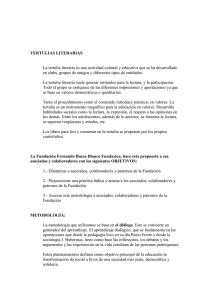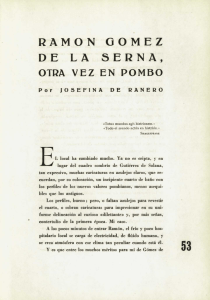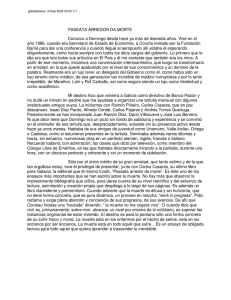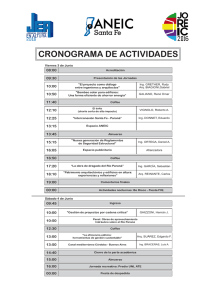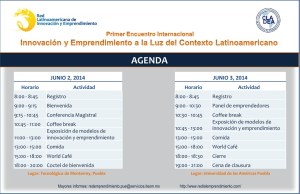TERTULIAS
Anuncio
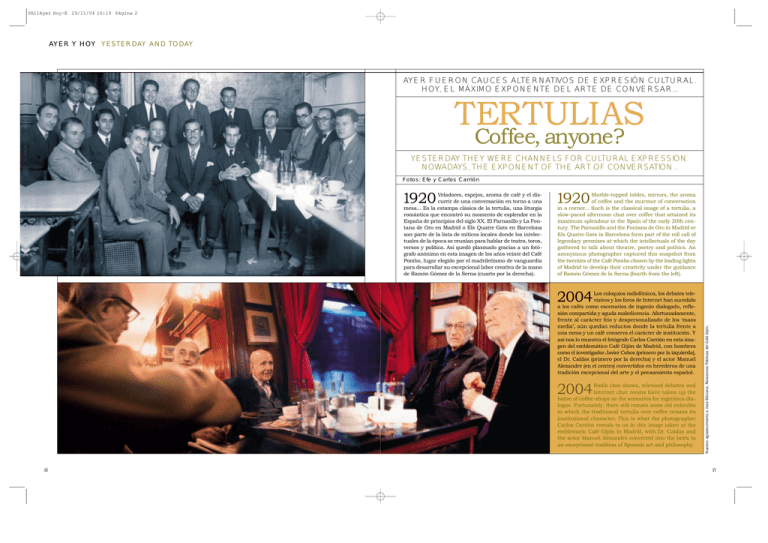
PA11Ayer Hoy-E 29/11/04 16:19 Página 2 AYER Y HOY YESTERDAY AND TODAY AYER FUERON CAUCES ALTERNATIVOS DE EXPRESIÓN CULTURAL. HOY, EL MÁXIMO EXPONENTE DEL ARTE DE CONVERSAR... TERTULIAS Coffee, anyone? YESTERDAY THEY WERE CHANNELS FOR CULTURAL EXPRESSION. NOWADAYS, THE EXPONENT OF THE ART OF CONVERSATION... Fotos: Efe y Carlos Carrión 1920 Veladores, espejos, aroma de café y el discurrir de una conversación en torno a una mesa... Es la estampa clásica de la tertulia, una liturgia romántica que encontró su momento de esplendor en la España de principios del siglo XX. El Parnasillo y La Fontana de Oro en Madrid o Els Quatre Gats en Barcelona son parte de la lista de míticos locales donde los intelectuales de la época se reunían para hablar de teatro, toros, versos y política. Así quedó plasmado gracias a un fotógrafo anónimo en esta imagen de los años veinte del Café Pombo, lugar elegido por el madrileñismo de vanguardia para desarrollar su excepcional labor creativa de la mano de Ramón Gómez de la Serna (cuarto por la derecha). 1920 Marble-topped tables, mirrors, the aroma of coffee and the murmur of conversation in a corner... Such is the classical image of a tertulia, a slow-paced afternoon chat over coffee that attained its maximum splendour in the Spain of the early 20th century. The Parnasillo and the Fontana de Oro in Madrid or Els Quatre Gats in Barcelona form part of the roll call of legendary premises at which the intellectuals of the day gathered to talk about theatre, poetry and politics. An anonymous photographer captured this snapshot from the twenties of the Café Pombo chosen by the leading lights of Madrid to develop their creativity under the guidance of Ramón Gómez de la Serna (fourth from the left). Los coloquios radiofónicos, los debates televisivos y los foros de Internet han sucedido a los cafés como escenarios de ingenio dialogado, reflexión compartida y aguda maledicencia. Afortunadamente, frente al carácter frío y despersonalizado de los ‘mass media’, aún quedan reductos donde la tertulia frente a una mesa y un café conserva el carácter de institución. Y así nos lo muestra el fotógrafo Carlos Carrión en esta imagen del emblemático Café Gijón de Madrid, con hombres como el investigador Javier Cobos (primero por la izquierda), el Dr. Caldas (primero por la derecha) y el actor Manuel Alexandre (en el centro) convertidos en herederos de una tradición excepcional del arte y el pensamiento español. 2004 Radio chat shows, televised debates and Internet chat rooms have taken up the baton of coffee-shops as the scenarios for ingenious dialogue. Fortunately, there still remain some old redoubts in which the traditional tertulia over coffee retains its institutional character. This is what the photographer Carlos Carrión reveals to us in this image taken at the emblematic Café Gijón in Madrid, with Dr. Caldas and the actor Manuel Alexandre converted into the heirs to an exceptional tradition of Spanish art and philosophy. 40 Nuestro agradecimiento a José Bárcena, Relaciones Públicas del Café Gijón. 2004 41

